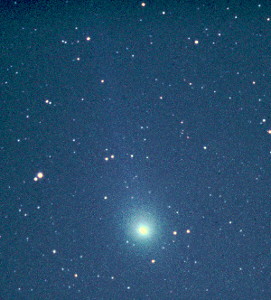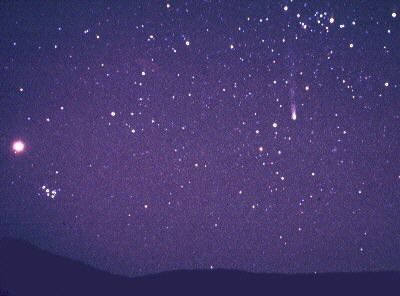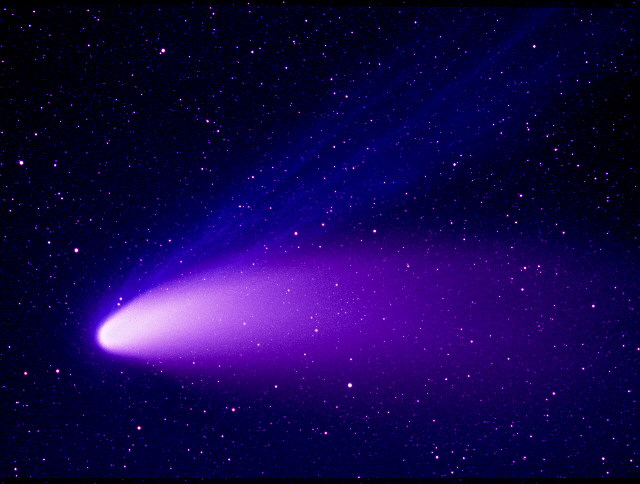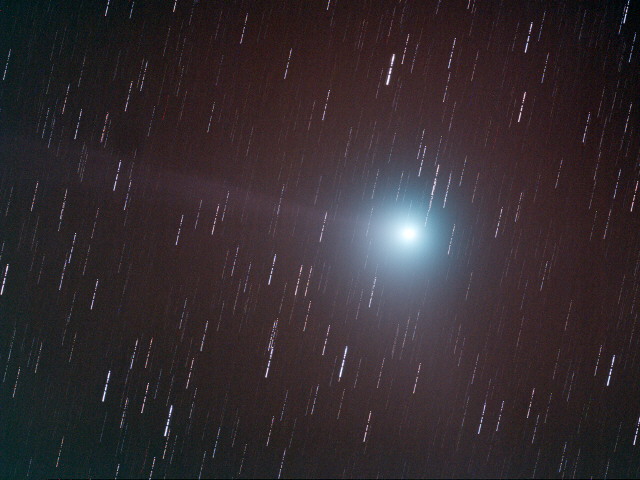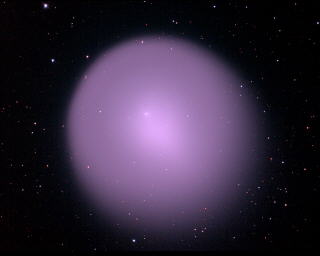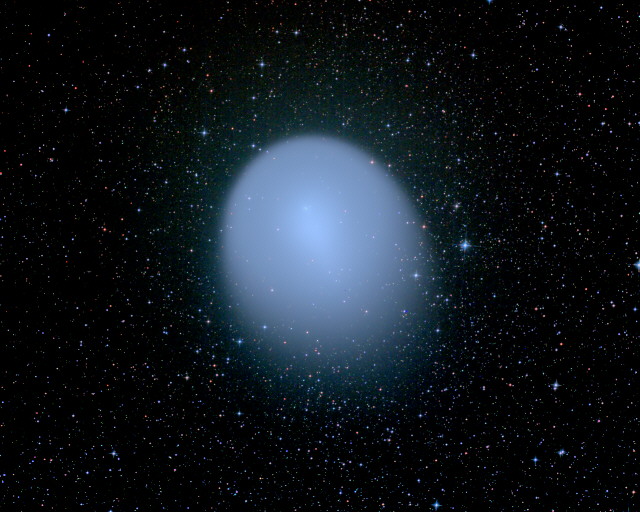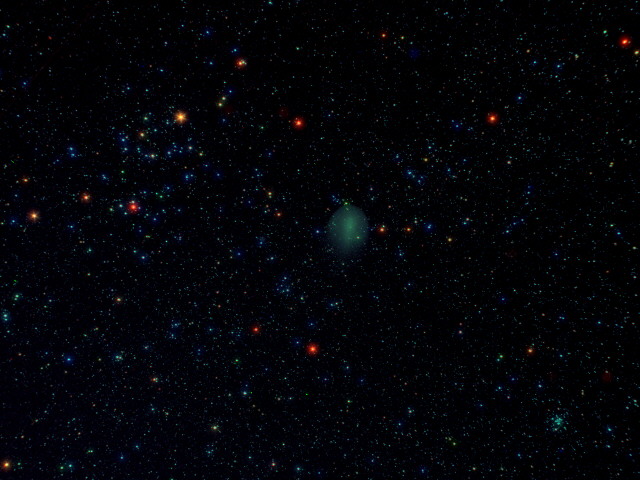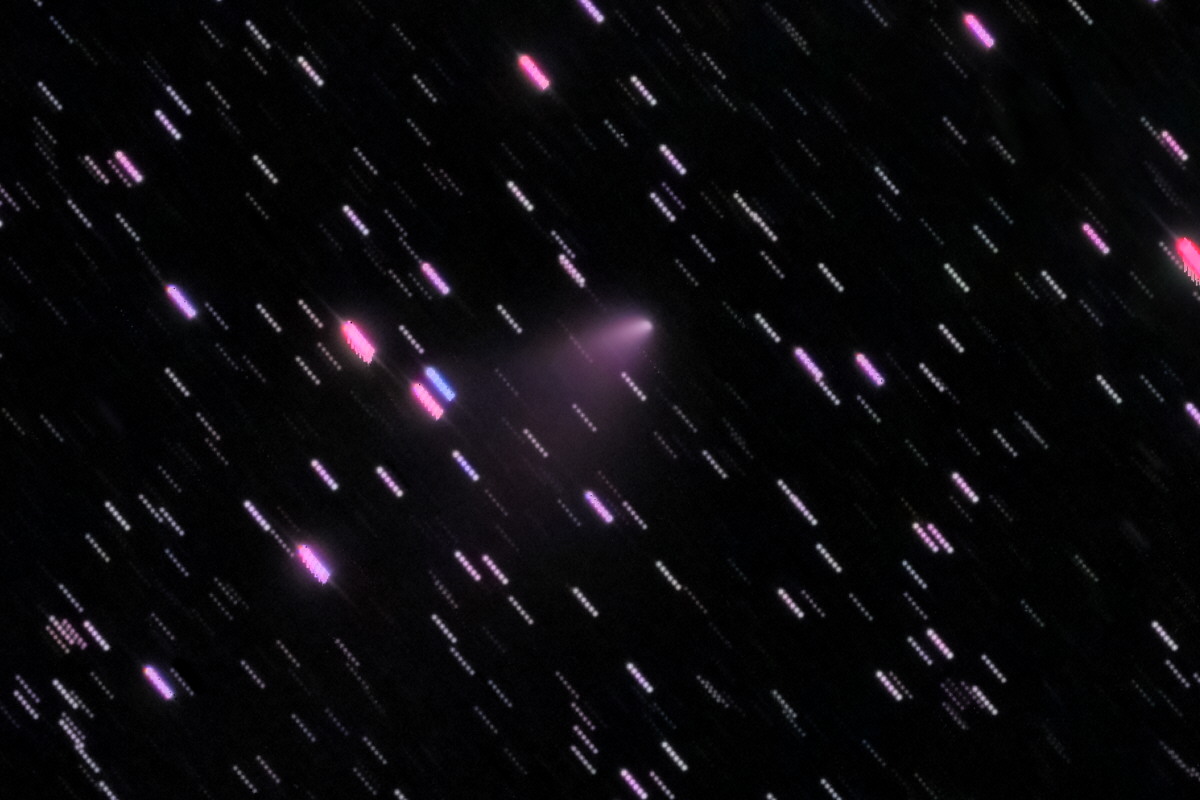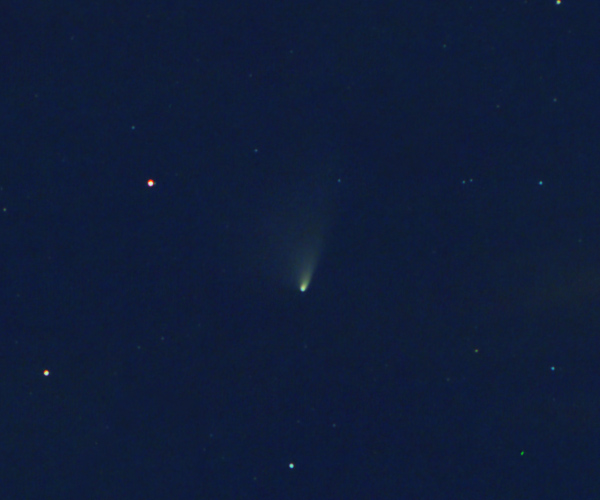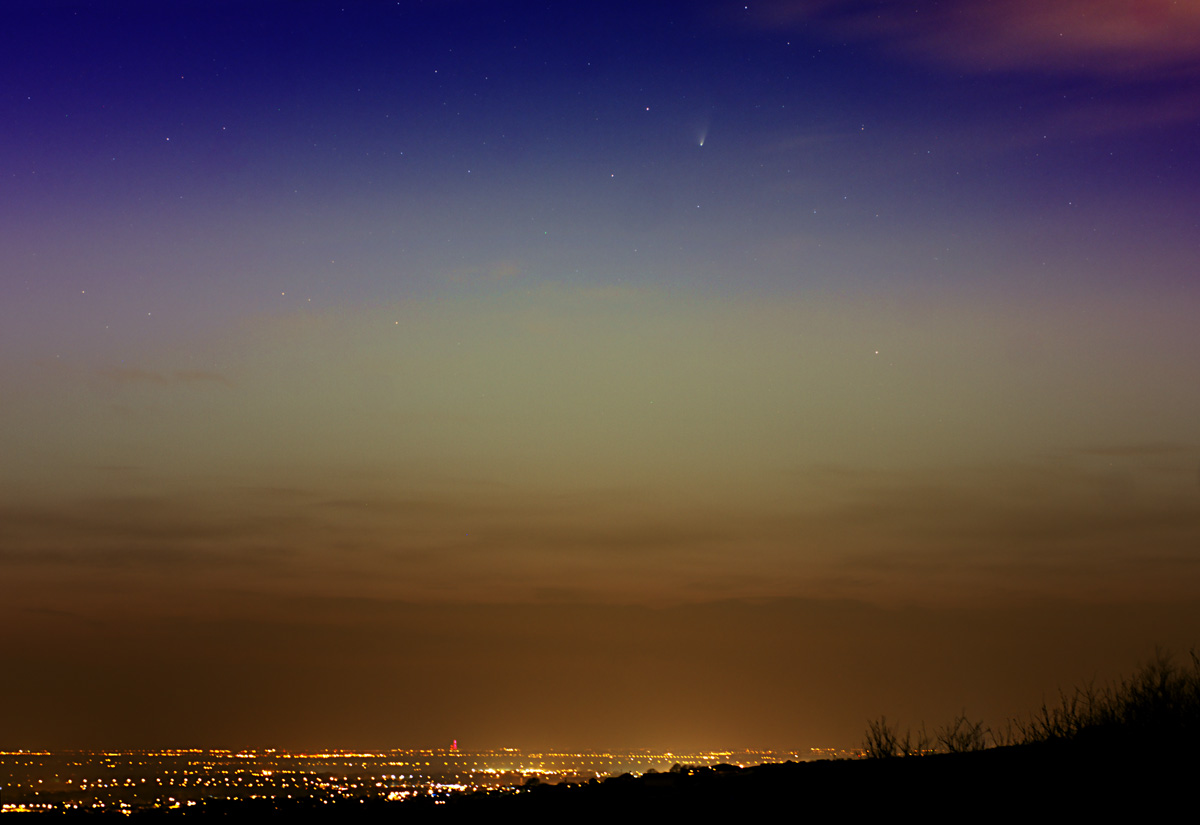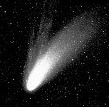
|
Comet NostalgiaA walk down memory lane for Comet lovers |
 |
| From seeing Comet Arend-Roland over the rooftops of Lancashire as a boy, Comets have always held a fascination for me. I did manage to see Comet Kahoutek - just - but it was the return of Halley's Comet in 1986 that re-awakened my interest. In this selection of photographs and images I have included the good, the bad and the ugly. If it's the latest breaking comet news you are interested in then please visit IAU's headlines pages. It's pure Nostalgia here! |
Contents:-
Version 4.2css |
Comet Arend-Roland 1957. |
| Comet Halley
1985/6
Although it was to make its closest approach during spring 1986, it was only during late 1985 that Halley was well placed for viewing from the northern hemisphere. |

|
My first glimpse of Halley's Comet was in the early hours of
October 25th. I took two images not realising that its movement would be
so evident in one hour. These images were published in the Bolton Evening
News. Both pairs were taken with my 12.5inch Newtonian with exposures of
around 10 minutes.
The second pair was taken 3 weeks later and Halley was much brighter. These images were used by the Lancashire Evening Post and got me me into trouble. The local polytechnic, which runs its own observatory, had published its picture which was awful. When the newspaper saw my picture they splashed on a full page. Needless to say the polytechnic were not pleased that an amateur had taken a better picture than the professionals. |
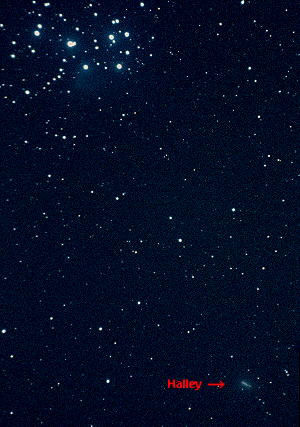 Halley and the Pleiades |
On the 17th November, Halley passed below the Pleiades giving the opportunity for a unique picture. Amazingly it was clear in Lancashire, as it was much of the month, and I was able to get this picture. I used a 300mm f5.6 lens which fitted them both in. The motion of Halley is very apparent. |
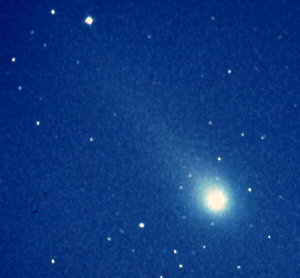 |
During December, Halley brightened but for us northern observers it had started it dive south. This was my last photo taken with my 12.5inch f/6 Newtonian and my only one where a tail has become obvious. It would still be visible in early January 1986 but it was then too low for me to photograph. It was of course best seen from the Southern hemisphere where it brightened considerably and "grew" a prominent tail. |
| Comet Bradfield
1987s
With this comet, his thirteenth, Australian Bradfield became the most prolific comet discoverer of this century. He was later to be overtaken by the Shoemakers. |
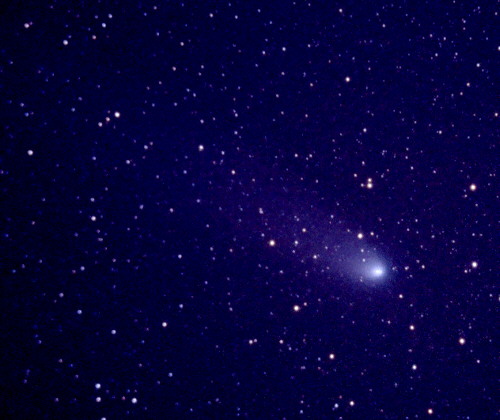 |
Not a spectacular comet but it did reach unaided eye visibility, peaking around magnitude 4 in November. From our part of the world, it was actually brighter than Halley but went virtually unnoticed. My picture was taken early December 1987 using a 6 inch f3.6 Schmidt-Newtonian. |
|
Comet Levy 1990c Discovered by David Levy of Sky and Telescope magazine, this comet was probably the brightest after Halley, although still not the big one we were waiting for. |
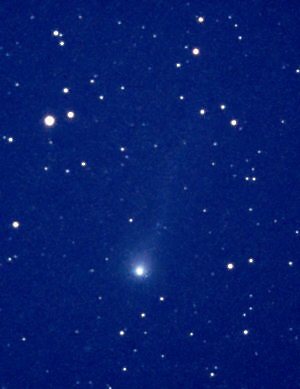 |
Both these photos were taken with a 6inch f3.6 Schmidt-Newtonian. The picture left was taken in July when the comet was small but showed a twisted gas tail. A month later (below) the comet was bigger but the gas tail was fainter.
|
|
Comet Swift-Tuttle
1992
Comet Swift-Tuttle is one of the biggest known periodic comets and achieved much notoriety when the popular press realised that it could collide with Earth. |
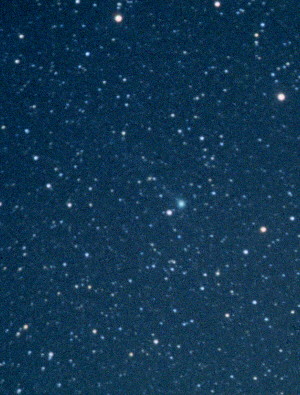 Comet Swift-Tuttle 1992 |
It was seen in 1862 and named Swift-Tuttle after its
discoverers with its orbit calculated as approximately 120 years. However
its fame is due to the fact that it could one day collide with Earth as
the two orbits intercept each other. In fact debris left by this comet
causes the Perseid meteor shower, which is visible every July and August.
There was much interest in recovering this comet for obvious reasons. When
it failed to reappear there was speculation that it had perhaps
disintegrated. It was eventually recovered in 1992, 10 years later than
predicted. Based on new observations, its orbit was recalculated and it
was found to have been seen many times before going back 2000 years, being
in fact Comet Kegler of 1737. However it proved impossible to calculate a
reliable orbit but using the best information the Comet will miss Earth by
15 days in 2126. You can sleep easily in your beds now!
Its appearance in 1992 was one of its worst, requiring binoculars to see it. My image here just about reveals its tail. It was taken on 13th November 1992 using a 135mm telephoto lens. |
|
Comet Hyakutake
1996
Comets are like buses - none for a long time then two come at once.
Just as we were waiting for Hale-Bopp along came this one. Although not
intrinsically bright, its close passage to earth meant that it was
spectacular with probably the longest tail in living memory. |
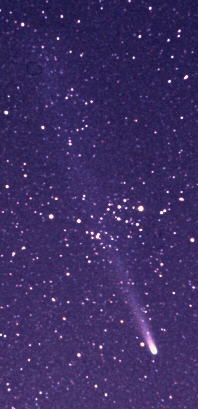 Receding from Earth |
The picture left was taken on 5th April when it was much further away. It still shows a reasonable tail but nothing like the size of that during its closest week. My final view was in April over the Howgill Fells with Venus at the left - can you spot the California nebula?
|
|
Comet Hale-Bopp 1997
For once a comet that lived up to expectations. Because of its location in the sky, vision of it was blocked out from my Lancashire observatory. The images here were all taken from Cumbria using telephoto lenses and film, which turned out to be ideal for recording this large comet.
|
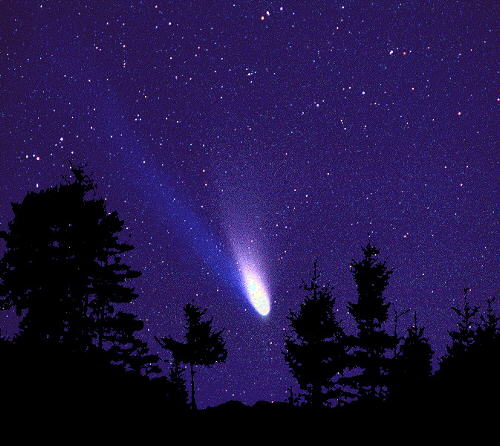 |
At this time, Comet Hale-Bopp was both a morning and evening object. This image was taken on Sunday (5:05am) 9th March 1997 with 135mmf4 lens, exposure 2 minutes. To take it I set my camera tracker up in the middle of the A683 - there's not much traffic at that time in the morning! |
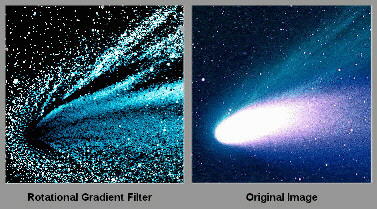 |
Digital image processing can reveal hidden details. In this case a rotational gradient filter has been used to show the jets coming from the cometary nucleus that would otherwise have been invisible. |
Comet 55P/Tempel-Tuttle 1998 This faint comet, with a period just over 33 years, is at first glance not worth a second look. However, its appearance belies its significance. It is in fact the "parent" of the well known Leonid meteor shower. This meteor shower has peaked dramatically following returns of the Comet in the past, such as the one of 1833 shown right. In more recent times, the 1966 shower was one of the most spectacular ever recorded and there has been intense speculation as to whether the same will happen again after its 1998 appearance. |
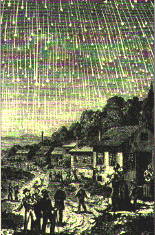 The Leonid meteor storm of 1833 |
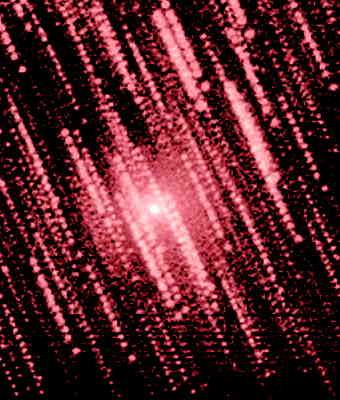 Comet Tempel-Tuttle |
Visually Temple-Tuttle is very disappointing. It is faint
and produces little dust so doesn't have a prominent tail and unless it
passes very close to Earth it will be inconspicuous. In fact in its 1899
and 1932 perihelion it wasn't even seen at all. In the 1998 approach it
was unfortunately closest before perihelion when it was approximately 33
million miles away and just seeing it was an achievement, which myself and
Gerald Bramall did with my 16 inch.
This image was taken by Gerald Bramall and myself on 19th January 1998 using a 6 inch Schmidt-Newtonian and a HiSIS CCD camera. It is a composite of 13 x 1-minute exposures - hence the multiple star images caused by the extremely rapid movement of the comet. This image was selected as "Picture of the Day" by the NASA/Ames Research Center for their Leonid 1998 Website. |
|
Comet 21P/Giacobini-Zinner
1998
Just like Tempel-Tuttle, this comet is famous for its meteor shower rather than its disappointing appearance. The meteor shower derived from it is the Giacobinids or Draconids. As there are several Draconids it is best to stick with the former name when talking about its asscoiated meteors. Giacobini-Zinner is one of Jupiter's family of comets with its furthest point from the Sun being just outside Jupiter's orbit. Its period is 6.6 years and the Earth intersects its orbit on the 8th or 9th of October. The best showers seem to occur when the comet itself has just passed this point, leaving debris behind. |
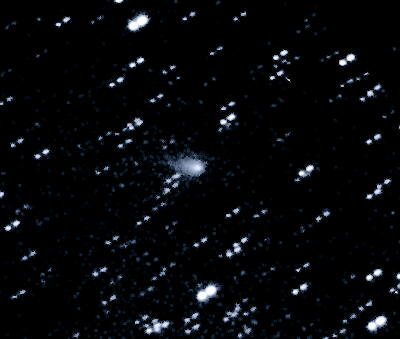 Comet Giacobini-Zinner |
In 1933 there was a spectacular Giacobini meteor storm
visible across Europe. Again there was a great storm in 1946 with a lesser
one in 1985, but most years bring nothing at all. Only time will tell what
this year's close encounter will bring on the evening of 8th October 1998!
One thing is certain if there is a storm, only those outside looking will
see it!
This image was taken by Gerald Bramall and myself on 2nd October 1998 using a 6 inch Schmidt-Newtonian and a HiSIS CCD camera. It is a composite of 5 x 1-minute exposures - with a break for clouds which resulted in split star trails. |
|
Comet Lee 1999
H1
Comet Lee was discovered by Steve Lee in April 1999 at a star party near Mudgee, Australia. |
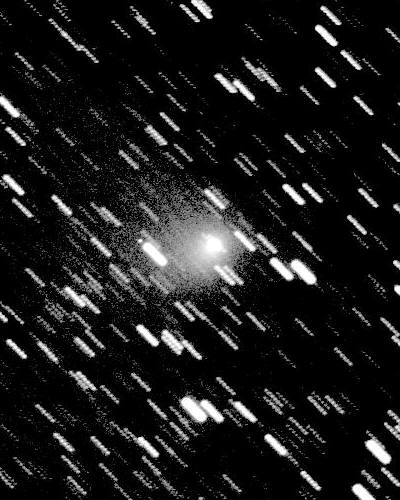 Comet Lee 1999 H1, 4th October 1999 |
Steve was to give a talk at the Party about the planetary
nebula (PN) NGC5189 and decided to take a look at it first through a
friends 16 inch Dobsonian. He failed to find the PN but came across an
unfamiliar object which looked like a comet. It was about magnitude 9 and
was clealy moving! After frantic phone calls, Steve managed to inform
Brian Marsden and the rest is history. But if Steve had been using a
computer controlled telescope, which would have gone straight to NGC5189,
he would not have made his discovery!
Steve and I had been working together on images for a new book and it wasn't until that was out of the way that I had time to take at look. There had been sightings of an anti-tail in August but I was too late. This image was taken on 4th October 1999 using a 6 inch Schmidt-Newtonian and a HiSIS CCD camera. It is a composite of 6 x 90 second exposures. |
| Comet Linear
WM1/2000
Although discovered in 2000 it was late 2001 when the comet reached its best in northern lattitudes. |
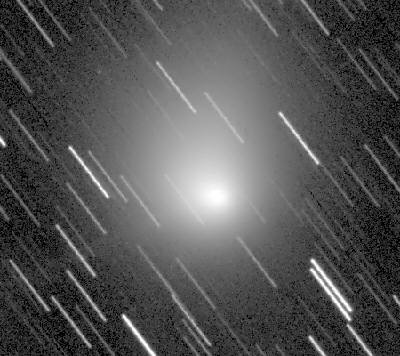 Comet Linear WM1/2000 , 22nd November 2001 |
A feature of this comet was the speed with which it moved
across the sky. This is evident in the lengths of the star trails in my
image, in just 30 minutes. I was also able to make a movie from the images
showing its speed. The movie file is unfortunately too large to fit here.
Evident in the image is a faint jet at the 8 o' clock position. The comet was imaged when left (east) of the Square of Pegasus. It was taken on 22nd November using a 6 inch Schmidt-Newtonian and a HiSIS CCD camera. It is a composite of 50 x 30 second exposures. |
| Comet Ikeya-Zhang
2002
From a dark site this was a spectacular naked-eye comet with the tail plainly visible. 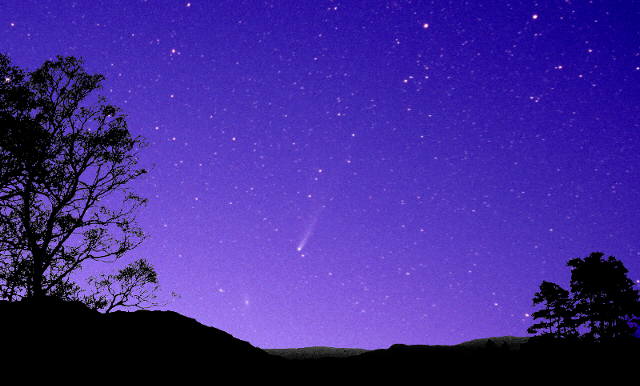 Wide view with 50mm lens - note M31 below an left |
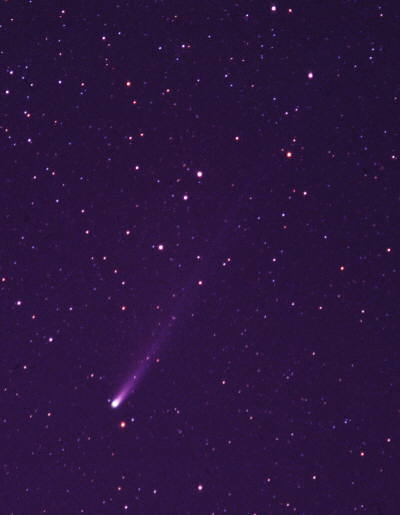 Shot with 135mm lens |
It was one of those comets that starts in the west as an evening object and works it way around the northern sky to become a morning object in the west. It was never in view from my observatory so I had to resort to film and a simple camera tracker. These photos were taken from Cumbria during twilight - it doesn't get dark till midnight up there at that time of year. They were taken on the 6th April 2002. |
| Comet Machholz, C/2004
Q2
For once a comet favourably placed for observers in the Northern
Hemisphere! It was at its best in January 2005. |
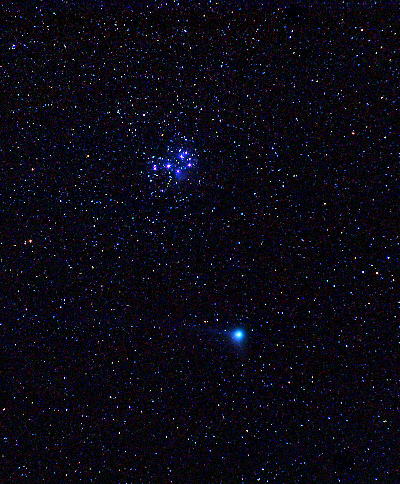 Shot with 50mm lens and Pentax *ist Digital |
Visually it was a big green blob which was easy in binoculars, even from light polluted skies. However, the tails (dust and ion) were both too faint to see in binoculars. It passed within about 2 degrees of the Pleiades on the night of January 7th but that night was clouded out for me. Nevertheless on the previous night it was reasonably close to make a nice picture. |
Comet Holmes 17P, 2007 Wow - what a strange object! Overnight on 23/24th October 2007 an explosive outburst occurred on Comet Holmes taking it from an obscure magnitude 17 to about magnitude 2.8 in less than 2 days. Credited with being the first to spot this were J. A. Henríquez Santana on Tenerife in the Canary Islands and Ramón Naves in Barcelona. It soon became easily visible to the naked-eye as a extra "star" in Perseus. During the comet's outburst, its orbit took it to near opposition with respect to Earth, and since comet tails point away from the Sun, Earth observers were looking nearly straight down along the tail of 17/P Holmes, making the comet appear as a bright sphere. Certainly I had never seen a comet that looked so spherical. |
|
By late October the coma's diameter had increased from 3.3 arcminutes to over 13 arcminutes i.e. about half the diameter of the Moon. At a distance of around 2 AU, this meant that the true diameter of the coma had swelled to over 1 million km, about 70% of the diameter of the Sun. By the 9th November the coma had dispersed to an area larger than the sun, briefly giving it the largest atmosphere in the solar system! By December it was around the same size in the sky as the Moon but it was getting fainter and was no longer an easy naked-eye object. It now needed a dark sky. What caused the outburst? Most likely was a build-up of explosive gases inside it. Will it explode again? Probably because it has done so twice before. Better keep an eye on it! |
My first image of Comet Holmes taken on 5th November 2007 with 12.5inch RCOS and Canon 20Da. It soon became too large an object for this telescope. |
Comet Holmes on 11th November 2007. Taken with Takahashi FSQ106 and Canon 20Da. At this stage the comet was an easy naked-eye object and superb in binoculars. |
|
Wide-field view of Comet Holmes in Perseus on 10th December 2007. The comet was now much larger but getting fainter. |
|
|
Comet Lulin, C/2007 N3 Because this comet was on a retrograde orbit and inclined almost along the ecliptic, it moved realtively swiftly across the sky from east to west during the early part of 2009. It was discovered by Ye Quanzhi and Lin Chi-Sheng from Lulin Observatory in China so it is named after its place of discovery rather than its discoverers. It was a binocular comet reaching about magnitude 6. I was hoping to image it as it passed Saturn going the other way but the weather did not cooperate. However, it did clear at the time of its passage in early March below the Behive Cluster, M44 and above the Open Cluster M67 although there was a very bright Moon present which hampered visibility.
|
|
Comet Hartley in 2010, 103P/Hartley 2 Despite having a short-period (6.3 years) this comet was only discovered in 1986. The explanation is that close encounters with Jupiter in the last 100 years or so were sufficient to change its orbit so that only recently does it come into the inner solar system and close enough for us to see it. The 2010 return was the best ever with it passing only 0.12 AU from Earth on October 20.
|
|
C/2009 P1 Garradd, visible 2011 Although not a naked eye comet, Comet Garradd was well placed for observing in August 2011. It was due to pass close to M71 on the 26th but that night was clouded out. There were just a few gaps in the clouds around twilight on the following night (27th) for me to grab a couple of frames.
|
|
Comet 168P/Hergenrother, visible 2012 The comet was at perihelion on 1 October 2012 and was expected to reach about apparent magnitude 15-16 but due to an outburst it brightened to magnitude 8. This outburst also seems to have caused it to frgament although my image on 15th November 2012 shows no obvious second nucleus.
|
|
Comet Panstarrs (C/2011 L4), visible 2013
|
Hope you enjoyed the walk down memory lane. If you want to use any of the images please ask first.

